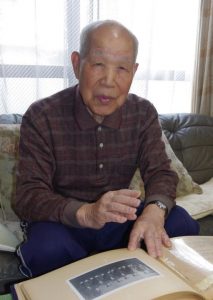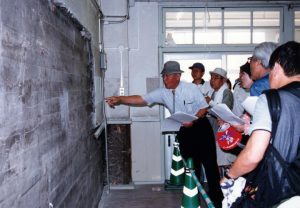My guidepost, Hiroshima pioneers: Kunihiko Sakuma, 79, chair of Hiroshima Prefectural Confederation of A-bomb Sufferers Organizations, speaks about Tadayuki Kusunoki, former teacher
May 20, 2024
Mr. Kusunoki showed our responsibility to face history
by Kana Kobayashi, Staff Writer
Kunihiko Sakuma has served as chair of the Hiroshima Prefectural Confederation of A-bomb Sufferers Organizations (Hiroshima Hidankyo) for nine years. He rides his bicycle every day to his Hiroshima downtown office, where he continues to counsel atomic bomb survivors who remain concerned about their lives and health. He attends a variety of meetings as he continues to strive toward the elimination of nuclear weapons.
“If I had not met Mr. Kusunoki, I might not have lived this life.” Mr. Sakuma mentioned the name of his former teacher, who had poured his heart and soul into the peace movement and peace education in the A-bombed city of Hiroshima. Mr. Kusunoki passed away in June 2022 at the age of 98.
Mr. Kusunoki was a social studies teacher at Kogo Junior High School, located in the city’s Nishi Ward, where Mr. Sakuma started attending in 1957. He was impressed by his teacher, who spoke passionately about the significance of peace and Japan’s Constitution. When Mr. Sakuma became a second-year student, Mr. Kusunoki was his homeroom teacher. “I was shy, but he taught me about the importance of action, saying, ‘Don't worry about making a mistake, just act,’” Mr. Sakuma said, recalling those days.
As an educator, Mr. Kusunoki had a strong will “that his students not be sent to war,” prompted apparently by his own bitter experience in war. He graduated early from Hiroshima Higher Normal School (present-day Hiroshima University) and enlisted in the navy. He was in Lushun, China when Japan lost the war, and then experienced detention by the former Soviet Union.
Mr. Kusunoki, who was demobilized in 1947, was shocked by Japan’s new Constitution, with its clear acknowledgment of the sovereignty of the people and renunciation of war, leading him to seriously reflect on the education system in place in Japan before and during the war. Although already teaching science at a private school, he started attending Hiroshima University of Literature and Science (present-day Hiroshima University) to reassess the field of education under Arata Osada, a professor who had worked to compile Children of the A-bomb, a collection of boys’ and girls’ personal accounts about the atomic bombing.
After becoming a teacher at a public middle school, Mr. Kusunoki put all his energy into peace education. When the film “Hiroshima” (1953), which depicted the horrors of the atomic bombing, was produced with the cooperation of many Hiroshima residents, he and his student volunteers worked as extras. He created materials for peace education with colleagues and busily engaged in the peace movement.
“His attitude seemed to indicate that everyone, not just the A-bomb survivors, needed to come to terms with the anti-nuclear peace movement,” Mr. Sakuma said, adding that Mr. Kusunoki’s actions made him, as an A-bomb survivor who had been reluctant to face that fact, reflect on his own attitudes.
Mr. Sakuma was nine months old when he was exposed to the flash of light from the atomic bombing at his home in the area of Koi (now part of Hiroshima’s Nishi Ward), but he neither is aware of nor remembers that situation. Having “wanted to forget that I was a survivor,” he dropped out of college and went to Tokyo, as if running from the issue, in the mid-1960s.
That was at the height of the Cold War, when social campaigns, such as the anti-nuclear movement, were gaining momentum. One day in 1967, his acquaintance invited him to participate in an anti-nuclear rally in Shizuoka, where he unexpectedly met Mr. Kusunoki, who told him, “Take good care of yourself.” He was struck by his teacher’s unwavering attitude of demonstrating his hopes through action.
The next year, Mr. Sakuma returned to Hiroshima. While working for a company in his hometown, he followed his teacher’s activities from a distance. Mr. Kusunoki successively held a variety of posts, including as a two-term member of the Hiroshima Prefectural Assembly and a representative director of the Hiroshima Council against Atomic and Hydrogen Bombs. He also worked on preserving A-bombed remains and structures that were disappearing over time as vice chair of the Atomic Bomb Remains Preservation Movement Association. He continued to look on as Mr. Kusunoki “never neglected to question the past and look ahead to the future.”
With the idea that, “I have to fulfill my own obligations,” Mr. Sakuma began listening to the survivors’ experiences as a counselor after his retirement. He also attends meetings in Japan and overseas to communicate the voices of people in the A-bombed city of Hiroshima on behalf of elderly survivors unable to move about freely.
“We must change our society.” Such words spoken by Mr. Kusunoki often come back to Mr. Sakuma since he became involved in the movement. Although the words did not resonate with him at the time, Mr. Sakuma now interprets them as calling on people to “look at the essence of the atomic bombing of Hiroshima and take action.” He said, “The defeat in the war did not completely improve Japanese society. We have many problems from the past that linger today, so we must learn from history and question the present.”
At a time when responsibility for the past is blurred by the words “reconciliation” and “future-orientation,” and when the mayor of Hiroshima City uses excerpts from the prewar “Imperial Rescript on Education,” repudiated by the country’s Constitution, in the city’s staff training materials, Mr. Sakuma keeps a watchful eye on today’s A-bomb city and continues to raise his voice.
Kunihiko Sakuma
Kunihiko Sakuma was born in Hiroshima City. After dropping out of the Hiroshima Institute of Technology in 1964, Mr. Sakuma went to a vocational school in Tokyo and worked at a hotel. He returned to Hiroshima in 1968 and worked for Mitsubishi Heavy Industries’ Hiroshima Machinery Works, from which he retired in 2005. Since 2006, he has worked as a counselor at the A-bomb Survivors Counseling Agency of the Hiroshima Prefectural Confederation of A-bomb Sufferers Organizations (Hiroshima Hidankyo). In 2015, he assumed the post of chair of Hiroshima Hidankyo, succeeding the late Kazushi Kaneko. He lives in Hiroshima’s Nishi Ward.
Keywords
The Atomic Bomb Remains Preservation Movement Association
The Atomic Bomb Remains Preservation Movement Association was formed in 1990 by researchers, atomic bomb survivors, and citizens in an effort to preserve A-bombed remains and structures that were disappearing in the rush to reconstruct and redevelop the city after World War II. The association continues its efforts to preserve the Rest House in the Peace Memorial Park, the former Hiroshima University Science Faculty No. 1 Building, and other structures through signature-collection campaigns and field work involving A-bombed remains. The association has published a guidebook and an anthology of photographs that trace the history of the A-bombed city of Hiroshima.
(Originally published on May 20, 2024)










